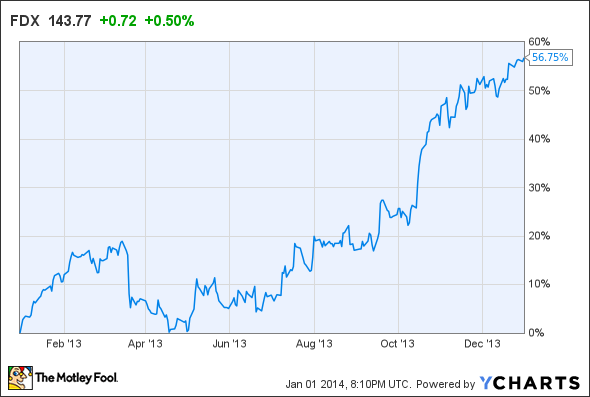It took FedEx (FDX 2.54%) stock a while to get off the ground last year, but by the end of 2013, it had registered an impressive 57% increase. FedEx's strong gains since May indicate that investors are becoming comfortable with its restructuring plans, and that they are excited about the company's stepped-up share repurchase program.
FedEx 2013 Price Chart, data by YCharts
After this strong 2013 performance, FedEx stock is likely to take a breather in 2014. FedEx now trades for 16 times the average analyst estimate for fiscal year 2015 earnings. While the company has good long-term upside due to the growth of e-commerce and improved efficiency, at this point it no longer seems dramatically undervalued.
The promise of profit
In 2012, the FedEx management team laid out a plan to improve FedEx's stock performance by cutting costs through a combination of headcount reductions, aircraft replacement, and the elimination of unprofitable capacity. The main target of cost cuts was the express division, which specializes in overnight package delivery. Over the years, it had become bloated relative to demand.

FedEx is looking to slash costs dramatically in its express division
It took a little while for the cost cuts to start kicking in. The express division routinely delivered an operating margin around 5% from fiscal year 2010 through fiscal year 2012, but for the fiscal year ending in May, the operating margin fell to 2%.
These recent results have been far short of FedEx's goal of maintaining an operating margin of at least 10% in each of its business segments. However, the express segment started to bounce back in the last two quarters as the early cost cuts start to take hold. The operating margin for the division rose to 3.6% in the August quarter and hit 4.8% in the November quarter (the second quarter of fiscal 2014).
This trend bodes well for FedEx's earnings in the next few years. There are plenty of additional cost cuts to come, which should drive the operating margin of the express segment into the high single digits and boost total company earnings by at least 50%. FedEx probably needs the global economic recovery to gain steam in order to reach the 10% operating margin target.
The big catalyst
While the promise of earnings growth driven by restructuring helped FedEx stock gradually move higher this summer, it took a share buyback announcement to spark a major rally. On Oct. 15, the company announced that it would add 32 million shares (roughly 10% of the total outstanding) to its ongoing share repurchase program.
This announcement signaled management's confidence in FedEx's long-term prospects. It also highlighted the ability of FedEx to buy back stock while also investing heavily in growth and fleet modernization initiatives. Indeed, the company quickly ramped up its buyback program, repurchasing 7.2 million shares of FedEx stock last quarter.
Looking ahead
FedEx's ongoing cost-cutting program should drive earnings growth for the next two to three years, with EPS reaching approximately $10-$12 by 2016. FedEx's ground division also represents a long-term-growth driver, because e-commerce probably has decades of above-market growth ahead of it.
However, after its recent run, FedEx stock already reflects both of these earnings growth opportunities. Unless the global economic recovery suddenly takes off or management finds additional cost savings, FedEx stock is unlikely to significantly outperform the market over the next few years.







